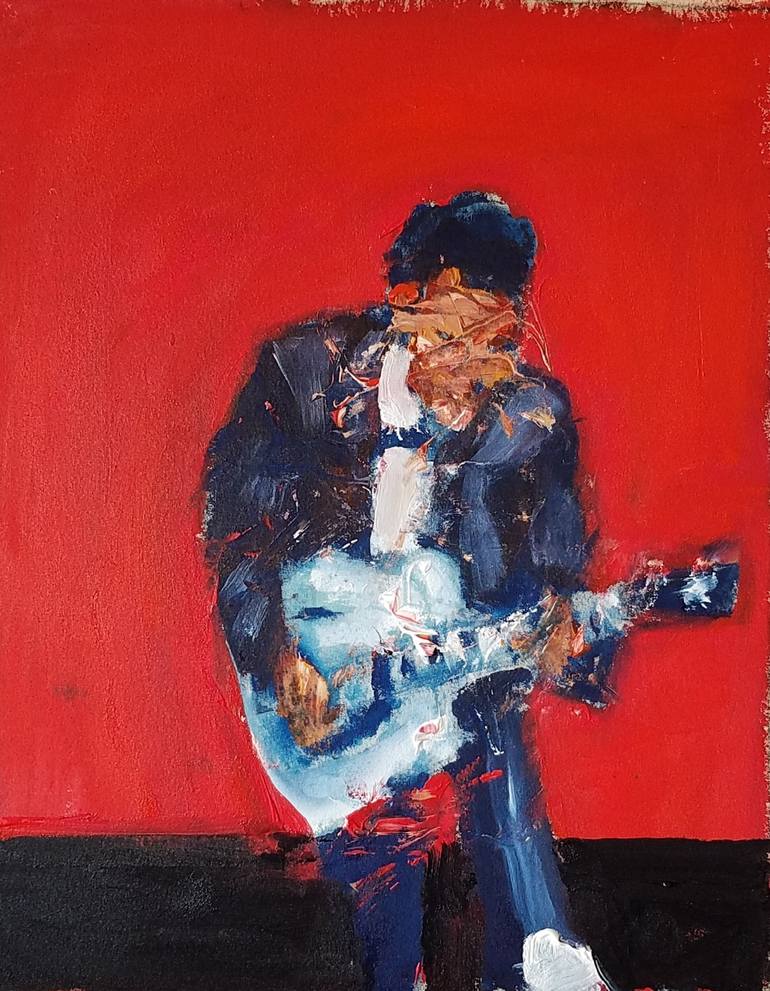


VIEW IN MY ROOM
Chuck Berry #2 Painting
United States
Painting, Acrylic on Canvas
Size: 30 W x 34 H x 1 D in
Ships in a Tube
Shipping included
14-day satisfaction guarantee
Artist Recognition

Artist featured in a collection
About The Artwork
Charles Edward Anderson Berry (October 18, 1926 – March 18, 2017) was an American singer, songwriter, musician, and one of the pioneers of rock and roll music. With songs such as "Maybellene" (1955), "Roll Over Beethoven" (1956), "Rock and Roll Music" (1957) and "Johnny B. Goode" (1958), Berry refined and developed rhythm and blues into the major elements that made rock and roll distinctive. Writing lyrics that focused on teen life and consumerism, and developing a music style that included guitar solos and showmanship, Berry was a major influence on subsequent rock music.[1] Born into a middle-class African-American family in St. Louis, Missouri, Berry had an interest in music from an early age and gave his first public performance at Sumner High School. While still a high school student he was convicted of armed robbery and was sent to a reformatory, where he was held from 1944 to 1947. After his release, Berry settled into married life and worked at an automobile assembly plant. By early 1953, influenced by the guitar riffs and showmanship techniques of the blues musician T-Bone Walker, Berry began performing with the Johnnie Johnson Trio.[2] His break came when he traveled to Chicago in May 1955 and met Muddy Waters, who suggested he contact Leonard Chess, of Chess Records. With Chess, he recorded "Maybellene"—Berry's adaptation of the country song "Ida Red"—which sold over a million copies, reaching number one on Billboard magazine's rhythm and blues chart.[3] By the end of the 1950s, Berry was an established star, with several hit records and film appearances and a lucrative touring career. He had also established his own St. Louis nightclub, Berry's Club Bandstand.[4] But in January 1962, he was sentenced to three years in prison for offenses under the Mann Act—he had transported a 14-year-old girl across state lines.[2][5][6] After his release in 1963, Berry had several more hits, including "No Particular Place to Go", "You Never Can Tell", and "Nadine". But these did not achieve the same success, or lasting impact, of his 1950s songs, and by the 1970s he was more in demand as a nostalgic performer, playing his past hits with local backup bands of variable quality.[2] His insistence on being paid in cash led in 1979 to a four-month jail sentence and community service, for tax evasion. Berry was among the first musicians to be inducted into the Rock and Roll Hall of Fame on its opening in 1986; he was cited for having "laid the groundwork for not only a rock and roll sound but a rock and roll stance."[7] Berry is included in several of Rolling Stone magazine's "greatest of all time" lists; he was ranked fifth on its 2004 and 2011 list of the 100 Greatest Artists of All Time.[8] The Rock and Roll Hall of Fame's 500 Songs That Shaped Rock and Roll includes three of Berry's: "Johnny B. Goode", "Maybellene", and "Rock and Roll Music".[9] Berry's "Johnny B. Goode" is the only rock-and-roll song included on the Voyager Golden Record.[10]
Details & Dimensions
Painting:Acrylic on Canvas
Original:One-of-a-kind Artwork
Size:30 W x 34 H x 1 D in
Frame:Not Framed
Ready to Hang:Not applicable
Packaging:Ships Rolled in a Tube
Shipping & Returns
Delivery Time:Typically 5-7 business days for domestic shipments, 10-14 business days for international shipments.
Handling:Ships rolled in a tube. Artists are responsible for packaging and adhering to Saatchi Art’s packaging guidelines.
Ships From:United States.
Have additional questions?
Please visit our help section or contact us.
United States
LARRY CAVENEY AND THE FOUR ELEMENTS by Mat Gleason What appear to be paintings from separate Larry Caveney series are actually held together in their conceptual approach, much as their subject matter might differ. They say dancers are as much athletes as those paid to play sports so there is a thread of connection there too. But look closer at what the artist does, the four elements are visible in all this work. Water: The element at the core of Caveney’s practice is the liquid paint he moves around to complete a composition. Frozen water is still water and the permanence of what he leaves can be seen as a purposeful, eternal splash. Air: The motion depicted here cuts through the air, swirls it all about, be it a dancer’s twirl across the ballroom floor or the bat of a superstar cutting toward the oncoming ball. In these pictures the air is disrupted by greatness and the painting captures this disruption. Fire: The energy on display burns with the heat of the subject’s intent but also the artist’s as well. The layers of meaning are derived from having captured the explosion of heat, each picture of Caveney’s is defined by what the subject burns. Earth: The solid object of the pictures is a manifestation of the element of earth. Even when depiction creates illusionistic space, even when the artist captures crystal moments in time and articulates their magic, the object itself is what guarantees its permanence, its earth. Larry Caveney is a painter, an artist and as evidenced by this work, an elemental magician.
Artist Recognition

Artist featured by Saatchi Art in a collection
Thousands Of Five-Star Reviews
We deliver world-class customer service to all of our art buyers.
Global Selection
Explore an unparalleled artwork selection by artists from around the world.
Satisfaction Guaranteed
Our 14-day satisfaction guarantee allows you to buy with confidence.
Support An Artist With Every Purchase
We pay our artists more on every sale than other galleries.
Need More Help?